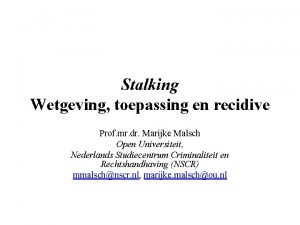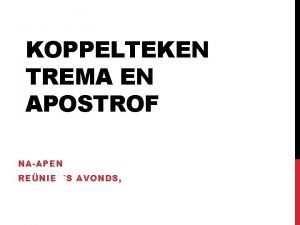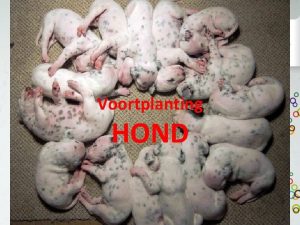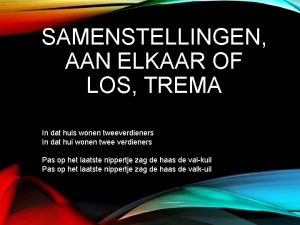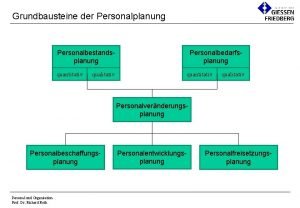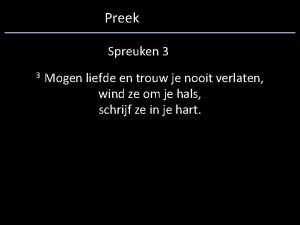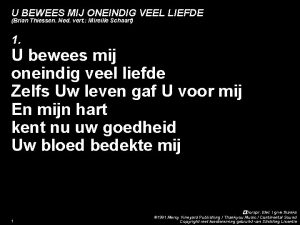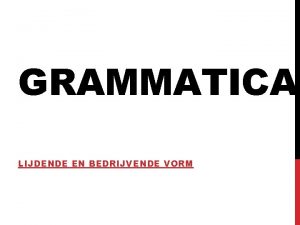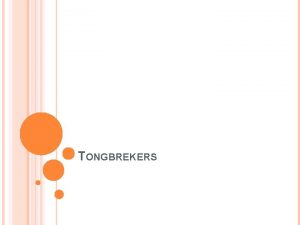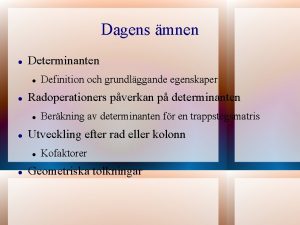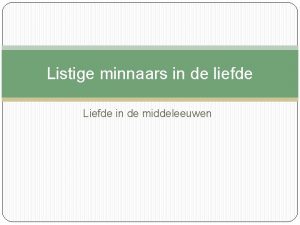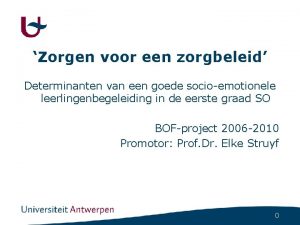STUDIEDAG WANNEER LIEFDE UITMONDT IN EEN GEVECHT DETERMINANTEN



![Stalking Versus ORI: Stalking: An unwanted and fear-inducing [intentional] pattern of intrusions or communication Stalking Versus ORI: Stalking: An unwanted and fear-inducing [intentional] pattern of intrusions or communication](https://slidetodoc.com/presentation_image_h2/5c1fc0791d81195e49b7d9602efd2835/image-4.jpg)
























- Slides: 28

STUDIEDAG WANNEER LIEFDE UITMONDT IN EEN GEVECHT… DETERMINANTEN, SCREENING & INTERDISCIPLINAIRE AANPAK Dinsdag 2 juni 2009 Faculteit Rechtsgeleerdheid Zeger van Hee - Tiensestraat 41 - 3000 Leuven

Meta-Analysis: • Descriptive meta-analysis based on 240 studies, representing 265, 000 cases/persons “The State of the Art of Stalking and Special Focus on the Relational Goal Pursuit Theory” 1/1 BRIAN H. SPITZBERG, Ph. D. 2

The State of the Art of Stalking And Special Focus on the Relational Goal Pursuit Theory Brian H. Spitzberg, Ph. D. , School of Communication San Diego State University • Descriptive meta-analysis based on 247 studies, representing 265, 000 cases/persons “The State of the Art of Stalking and Special Focus on the Relational Goal Pursuit Theory” 1/1 BRIAN H. SPITZBERG, Ph. D. 3
![Stalking Versus ORI Stalking An unwanted and fearinducing intentional pattern of intrusions or communication Stalking Versus ORI: Stalking: An unwanted and fear-inducing [intentional] pattern of intrusions or communication](https://slidetodoc.com/presentation_image_h2/5c1fc0791d81195e49b7d9602efd2835/image-4.jpg)
Stalking Versus ORI: Stalking: An unwanted and fear-inducing [intentional] pattern of intrusions or communication imposed on another (Mullen et al. , 2000) Obsessive Relational Intrusion: Unwanted pursuit of intimacy through repeated intrusions of privacy (Spitzberg & Cupach, 2001, 2002) INTIMATE RELATIONSHIPS ORI need not cause fear or threat ING STALK Stalking need not seek intimacy ORI IPV “The State of the Art of Stalking and Special Focus on the Relational Goal Pursuit Theory” BRIAN H. SPITZBERG, Ph. D. 4 1/1

Stalking Prevalence: META-ANALYSIS %SAMPLE STALKED*** %FEMALE VICTIMS** %MALE VICTIMS %THREAT USE** %PHYSICAL VIOLENCE ** %SEXUAL VIOLENCE DURATION (Mos. ) %KNOWN TO VICTIM %MALE PERPETRATOR* Clinical/ Forensic 35 57 19 51 41 12 17 85 80 SD 32 29 14 51 54 27 21 55 52 General Population 29 39 10 37 29 9 14 79 73 SD 25 23 15 21 16 11 8 22 12 College Samples 25 29 16 27 22 13 4 79 61 “The State of the Art of Stalking and Special Focus on the Relational Goal Pursuit Theory” BRIAN H. SPITZBERG, Ph. D. 5 SD 28 29 13 16 25 8 3 19 19 1/1

Cyber-Stalking Prevalence: All Stalking Harassment Any cyber-stalking or monitoring • Cyber-stalking 26. 6% 26. 1% 27. 4% • Electronic monitoring 23. 4 21. 5 26. 4 • E-mail 82. 6% 82. 5% 82. 7% • Instant messaging 28. 7 35. 1 20. 7 • Blogs or bulletin boards 12. 5 12. 3 12. 8 • Internet sites re: victim 8. 8 9. 4 8. 1 • Chat rooms 4. 0 4. 4 3. 4 • Computer spyware 44. 1% 33. 6% 81. 0% • Video/digital cameras 40. 3 46. 3 19. 3 • Listening devices 35. 8 41. 8 14. 8 9. 7 10. 9 5. 2 % of cyber-stalking involving: a % of monitoring involving: b • GPS “The State of the Art of Stalking and Special Focus on the Relational Goal Pursuit Theory” BRIAN H. SPITZBERG, Ph. D. 6 1/1

Sex Differences: • • • Females are 78% of victims (n=82); Males are 76% of pursuers (n=72). Perhaps males are…? : Pigs? less fearful of stalking, less likely to define stalking as stalking, more embarrassed to report, more pursuer, & females more ‘gatekeeper’ (Bjerregaard, ’ 00; Cupach & Spitzberg, ‘ 00; Davis et al. , 2002; Sinclair & Frieze, ’ 00; Tjaden & Thoennes, ’ 00; Tjaden et al. , ’ 00) “The State of the Art of Stalking and Special Focus on the Relational Goal Pursuit Theory” BRIAN H. SPITZBERG, Ph. D. 7 1/1

Sex Differences: A meta-analysis of 25 college samples (n > 7, 000) mostly SDSU college students, found: • Females find ORI more threatening than males do; • Females find male pursuers as more threatening than males find female pursuers; • Pursuers report perpetrating “unwanted pursuit” on females more than on males; • But female victims do not report more ORI or self-labeled “stalking” than males victims report; • And females and males do not differ in self-attributions of having engaged in “stalking” “The State of the Art of Stalking and Special Focus on the Relational Goal Pursuit Theory” BRIAN H. SPITZBERG, Ph. D. 8 1/1

Interactional Profile Intimacy Dimension ‘Normal’ Relationships ORI/Stalking Relationships Self. Disclosure Cautiously progressive Unregulated & Unreciprocated ‘torrent’ Liking & Loving Expressions of Commitment Displays caring & empathy consistent with stage Mutual negotiation of exclusivity Excess gifts, notes, calls, tokens, & professions of love Early & unilateral insistence on exclusivity; ‘fated future, ’ jealousy “The State of the Art of Stalking and Special Focus on the Relational Goal Pursuit Theory” BRIAN H. SPITZBERG, Ph. D. 9 1/1

Interactional Profile Intimacy Dimension ‘Normal’ Relationships ORI/Stalking Relationships Interests/ Activities Gradual & mutual interpenetration Increasingly non-mutual Physical Interaction Escalation of comfort intimacy, rapport, rituals, & synchrony P expresses desire & graphic scenarios, increasing ‘strain’ Closeness & Proximity Progressive but punctuated Hyperactive possessiveness “The State of the Art of Stalking and Special Focus on the Relational Goal Pursuit Theory” BRIAN H. SPITZBERG, Ph. D. 10 1/1

ORI/Stalking Topography: I. III. IV. V. VIII. HYPER-INTIMACY TACTICS MEDIATED CONTACTS INTERACTIONAL CONTACTICS SURVEILLANCE TACTICS INVASION TACTICS HARASSMENT & INTIMIDATION COERCION & THREAT TACTICS AGGRESSION/VIOLENCE TACTICS IX. P R O X Y p U R S U I T (> 250 tactic labels, study N = 40, Spitzberg, 2002) “The State of the Art of Stalking and Special Focus on the Relational Goal Pursuit Theory” BRIAN H. SPITZBERG, Ph. D. 11 1/1

Violence & Threats: Ø Threat use: 44% (n=91) Ø Sexual aggression: 12% (n=47) RSex. Viol =. 47 Ø Violence: 34% (n=98) p<. 001, n=45 R%roman =. 49 RF-prop =. 55 p<. 001, n=51 p<. 001, n=45 Ø > 50% with prior sexual relationship (Meloy, 2000; Rosenfeld, 2006) Ø Threats predict violence (r =. 37) (n=73, p<. 001) RClinical =. 24 RGen. Pop =. 36 RColl =. 77 ns, n=48 ns, n=14 p<. 001, n=14 Ø However: Ø false positive rates = 62% (n = 12) Ø false negative rates = 16% (n = 10) (C&S, 2004) “The State of the Art of Stalking and Special Focus on the Relational Goal Pursuit Theory” BRIAN H. SPITZBERG, Ph. D. 12 1/1

• Motives: “The desires of the heart are as crooked as corkscrews” (W. H. Auden, 1937) • INSTRUMENTAL (persecutory 1, predatory 2, revenge 3): • • Agenda (issue-based, disputes) Control (intimidation, isolation, possession) Instrumental Affect (attention-seeking, harass, humiliate, revenge, jealousy possessiveness, scare) EXPRESSIVE (amorous 1, affective 2, love 3): • • Affective (love, infatuation, jealousy, envy) Affective (anger, rage, betrayal, grief) Relational Bid (friendship, escalation, reconciliation) Sexual Attraction 1=Harmon et al. ‘ 98; 2=Meloy ‘ 01; 3=*Rosenfeld ‘ 00 “The State of the Art of Stalking and Special Focus on the Relational Goal Pursuit Theory” BRIAN H. SPITZBERG, Ph. D. 13 1/1

• Motives: “The desires of the heart are as crooked as corkscrews” • PERSONALOGICAL: • • (W. H. Auden, 1937) Incompetence: mental disorder, social incompetence CONTEXTUAL: • • • Break-up/separation/divorce Incidental Interactional Interdependence Nostalgia Rival 1=Harmon et al. ‘ 98; 2=Meloy ‘ 01; 3=*Rosenfeld ‘ 00 “The State of the Art of Stalking and Special Focus on the Relational Goal Pursuit Theory” BRIAN H. SPITZBERG, Ph. D. 14 1/1

Relational Goals Theory GOAL LINKING RELATIONAL ENTITLEMENT & PROPRIETARINES S SELFEFFICACY RUMINATION DETERMINATION ORI IDENTITY THREAT COGNITIV E SENSITIVITY BLAME AFFECTIV E HYPERINTIMAC Y AGGRESSION SURVEILLANCE “The State of the Art of Stalking and Special Focus on the Relational Goal Pursuit Theory” 1/1 BRIAN H. SPITZBERG, Ph. D. 15

Relational Goals Theory Kam & Spitzberg (2005): • GOAL LINKAGE (Investment Size, Commitment, Inclusion, Dependence, Relationship Thinking, Goal Linkage) predicted: • REJECTION-BASED AROUSAL (Perceived Rejection, Face Threat, Negative Arousal), which predicted: • RUMINATION ESCALATION (Thought Intrusion, Paradoxical Rebound), which predicted: • OBSESSION (Low CLALT, Obsession), which we hoped would predict: • ORI PERPETRATION • RESULTS: Optimal scaling regression (due to restricted variance of DV) accounted for 28% of the variance in ORI perpetration “The State of the Art of Stalking and Special Focus on the Relational Goal Pursuit Theory” BRIAN H. SPITZBERG, Ph. D. 16 1/1

Relational Goals Theory Cupach, Spitzberg, Younghans, & Gibbons (2006): • GOAL LINKAGE • RUMINATION & ANTICIPATORY EMOTIONS • SELF-EFFICACY • EMOTIONAL FLOODING • RECONCILIATION PERSISTENCE • ORI PERPETRATION • MODERATOR: Who initiated the breakup • RESULTS: • 59% reconciliation persistence accounted for by linking, rumination, and self-efficacy for those whose partner wanted out (vs. 32% for Ss who wanted out) • 16% ORI accounted for by linking, rumination, and self-efficacy, with no moderation “The State of the Art of Stalking and Special Focus on the Relational Goal Pursuit Theory” BRIAN H. SPITZBERG, Ph. D. 17 1/1

Effects/Symptoms: SOCIETAL SOCIAL RELATIONAL PERSONAL 4 th ORDER EFFECTS: Law Enforcement Moral Panic Societal Costs 3 rd ORDER EFFECTS: ‘Direct’ Impacts on Children Family Friends Colleagues 2 nd ORDER EFFECTS: Relations-Children Relations-Family Relations-Friends Relations-Colleagues 1 st ORDER EFFECTS: Physical Psychological Emotional Social Resource “The State of the Art of Stalking and Special Focus on the Relational Goal Pursuit Theory” BRIAN H. SPITZBERG, Ph. D. 18 1/1

Effects/Symptoms: GENERAL DISTURBANCE: e. g. , injured emotionally or psychologically; personality changed; PTSD; quality of life costs; etc. AFFECTIVE HEALTH: e. g. , anger; anxiety, depression, fear, frustration, feeling imprisoned, intimidated, jealousy, paranoia, stress, etc. ; COGNITIVE HEALTH: e. g. , confusion; distrust, loss of self-esteem, suspiciousness, helplessness/powerlessness; suicide ideation; , etc. BEHAVIORAL DISTURBANCE: e. g. , changing behavioral routines, change work/school/residence, etc. ; PHYSICAL HEALTH: e. g. , alcohol problems; appetite disturbance; cigarette smoking; insomnia; nausea; physical illness; suicide; etc. SOCIAL HEALTH: e. g. , avoid certain places/people; cautiousness; relationship deterioration; lifestyle disruption; etc. RESOURCE HEALTH: e. g. , disruption of work or school; financial costs; lost time from work; etc. SPIRITUAL HEALTH: e. g. , loss of faith, loss of religion, loss of belief in social institutions; etc. RESILIENCE: e. g. , develop stronger relationships with family or friends, develop greater selfefficacy/self-concept, etc. “The State of the Art of Stalking and Special Focus on the Relational Goal Pursuit Theory” BRIAN H. SPITZBERG, Ph. D. 19 1/1

Moving With A B “The State of the Art of Stalking and Special Focus on the Relational Goal Pursuit Theory” BRIAN H. SPITZBERG, Ph. D. 20 1/1

Moving Inward A B “The State of the Art of Stalking and Special Focus on the Relational Goal Pursuit Theory” BRIAN H. SPITZBERG, Ph. D. 21 1/1

Moving Against A BB “The State of the Art of Stalking and Special Focus on the Relational Goal Pursuit Theory” BRIAN H. SPITZBERG, Ph. D. 22 1/1

Moving Away A B “The State of the Art of Stalking and Special Focus on the Relational Goal Pursuit Theory” BRIAN H. SPITZBERG, Ph. D. 23 1/1

Moving Outward C A B D E “The State of the Art of Stalking and Special Focus on the Relational Goal Pursuit Theory” BRIAN H. SPITZBERG, Ph. D. 24 1/1

Coping—Prevalence: RELATIONAL RESPONSES: Ø Moving Against: Attempting to deter/punish pursuer Mean Prevalence 33% Ø Moving With: Attempting to negotiate/redirect relationship 25% Ø Moving Away: Attempting to avoid pursuer 25% EXTRA-RELATIONAL RESPONSES: Ø Moving Outward: Mobilizing assistance/input of others 32% Ø Moving Inward: Working on oneself 17% (> 18 studies, Spitzberg, 2002) “The State of the Art of Stalking and Special Focus on the Relational Goal Pursuit Theory” BRIAN H. SPITZBERG, Ph. D. 25 1/1

Law Enforcement: Contacts M N SD % Contact someone % Friends/family contact 75 59 8 14 22 25 % Contact police 42 41 26 % Police “helpful” 47 7 30 % Police “NOT helpful” † 45 5 15 † Reason for not reporting: 8% “attacker was a police officer” (NVAW, Tjaden & Thoennes, 2000, “Extent…” Ex. 17, n = 16, 000) † Reason why police didn’t take action: 6% “offender was police officer” (Suppl. Victimization Survey, Baum et al. , 2009, App. 12, n = 65, 000) “The State of the Art of Stalking and Special Focus on the Relational Goal Pursuit Theory” BRIAN H. SPITZBERG, Ph. D. 26 1/1

Law Enforcement: Protective Orders (PO) M N SD % Sought PO 45 15 36 % POs Violated* 38 24 25 % POs “Made Worse” 17 5 5 * Study of DV PO’s in Arizona indicates even when violated, most women FEEL better for obtaining a protective order (Johnson, Luna & Stein, 2003). “The State of the Art of Stalking and Special Focus on the Relational Goal Pursuit Theory” BRIAN H. SPITZBERG, Ph. D. 27 1/1

Further Information: • Brian H. Spitzberg, • • • Ph. D. , SDSU Senate Distinguished Professor spitz@mail. sdsu. edu To contribute to the meta-analytic data-base: http: //www. surveymonkey. com/s. aspx? sm=X 4 Gr. MTqo. MLIj. AEuj. NEs 7 AQ_3 d_3 d “The State of the Art of Stalking and Special Focus on the Relational Goal Pursuit Theory” BRIAN H. SPITZBERG, Ph. D. 28 1/1
 Wanneer stopt een narcist met stalken
Wanneer stopt een narcist met stalken Hijsbanden kleuren
Hijsbanden kleuren Apostrof oefenen
Apostrof oefenen Reu geslachtsrijp
Reu geslachtsrijp Wanneer gebruik je een trema
Wanneer gebruik je een trema Pbna vca vol
Pbna vca vol Determinanten definition
Determinanten definition Personalbedarfsplanung ablauf
Personalbedarfsplanung ablauf Helse liefde
Helse liefde Spreuken 3 vers 3 trouwtekst
Spreuken 3 vers 3 trouwtekst Oneindig veel liefde
Oneindig veel liefde Liefde korintiers
Liefde korintiers Heteronormativität
Heteronormativität Hierin is de liefde gods geopenbaard
Hierin is de liefde gods geopenbaard Liefde korintiers
Liefde korintiers Stellingen over seks
Stellingen over seks Onbepaalde rangtelwoord
Onbepaalde rangtelwoord Verschil lijdende en bedrijvende vorm
Verschil lijdende en bedrijvende vorm Piramide uitgevouwen
Piramide uitgevouwen Kanarie eitjes schouwen
Kanarie eitjes schouwen Wat is n draaiboek
Wat is n draaiboek Is een balans een momentopname
Is een balans een momentopname Een leven zonder dromen is als een tuin zonder bloemen
Een leven zonder dromen is als een tuin zonder bloemen Bladwijzer in atlas
Bladwijzer in atlas Schaaldeel liniaal
Schaaldeel liniaal Wat is een slot in een tekst
Wat is een slot in een tekst Spierfibrillen
Spierfibrillen Als een potvis in een pispot pist
Als een potvis in een pispot pist Een eigen huis een plek onder de zon
Een eigen huis een plek onder de zon
